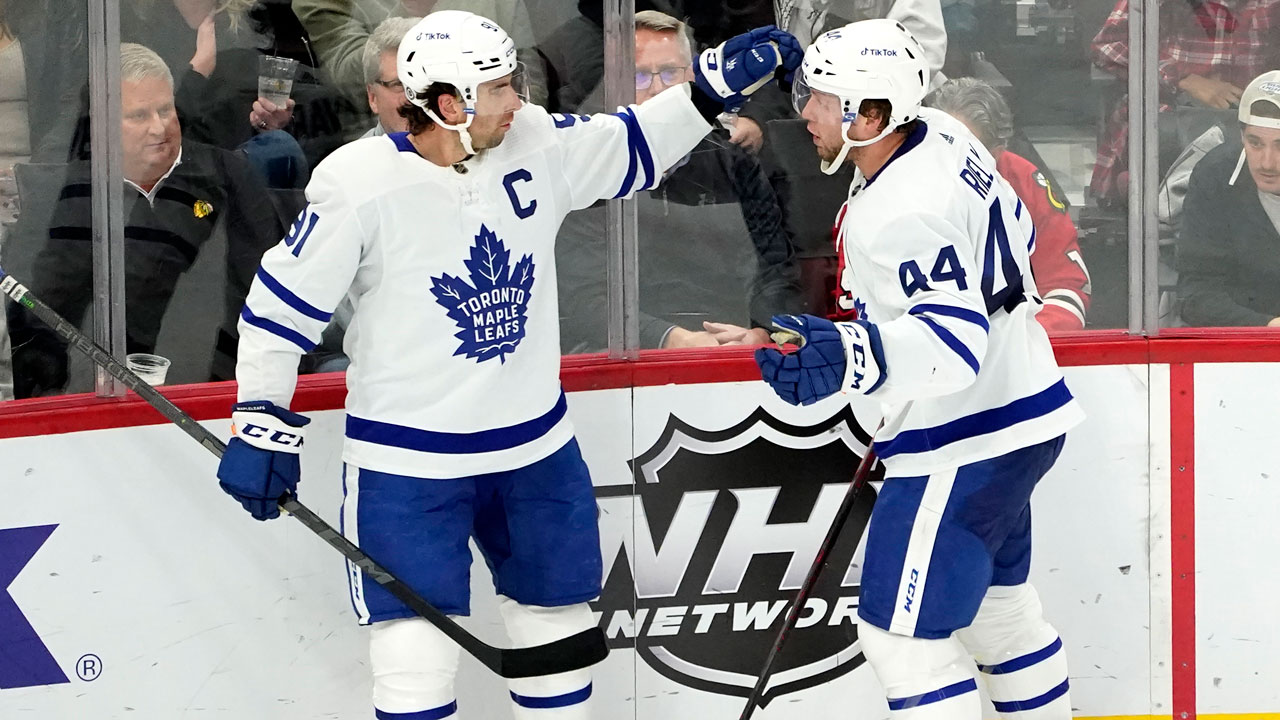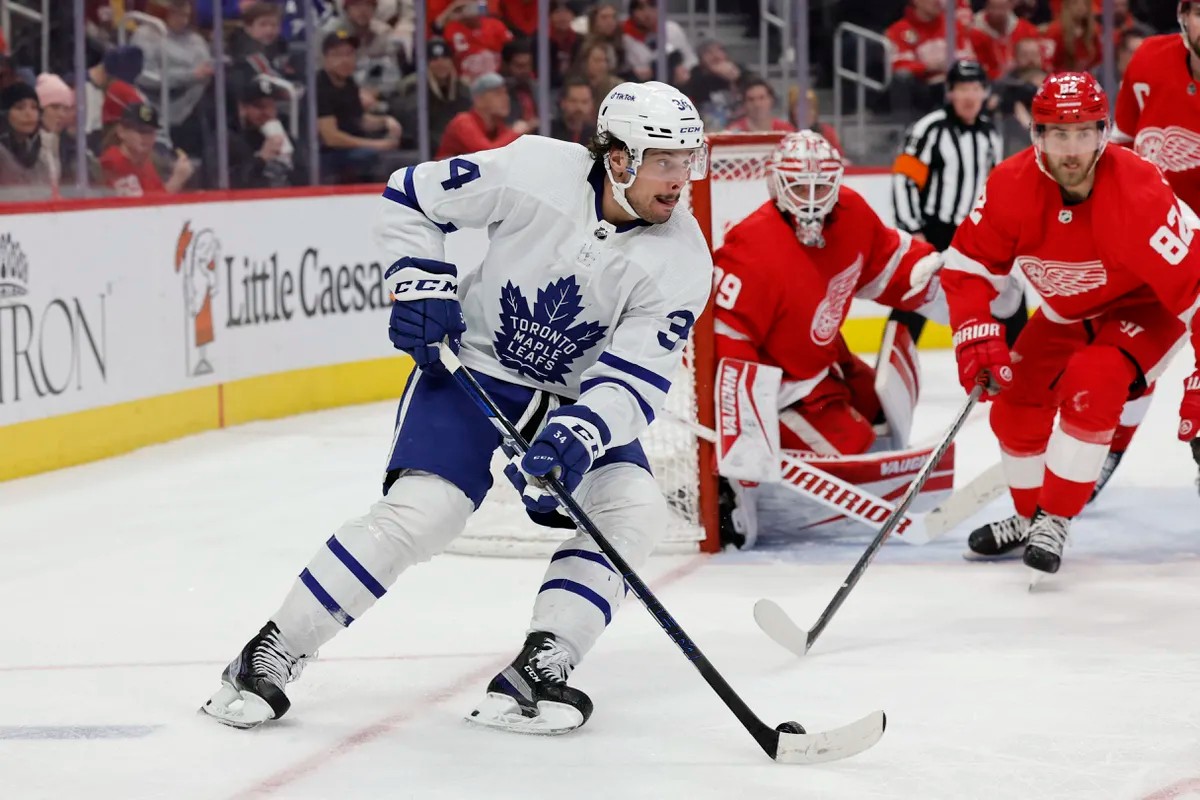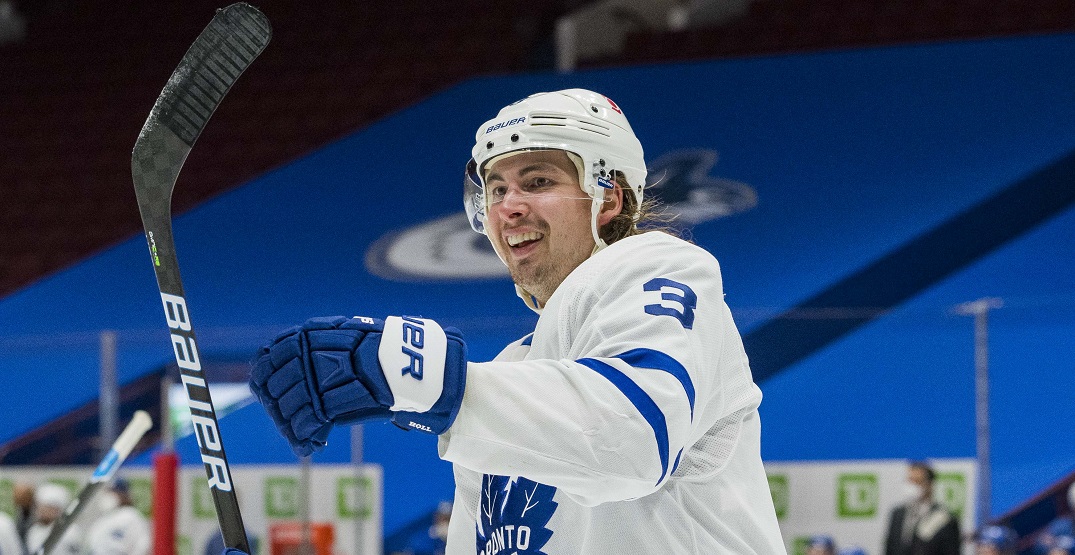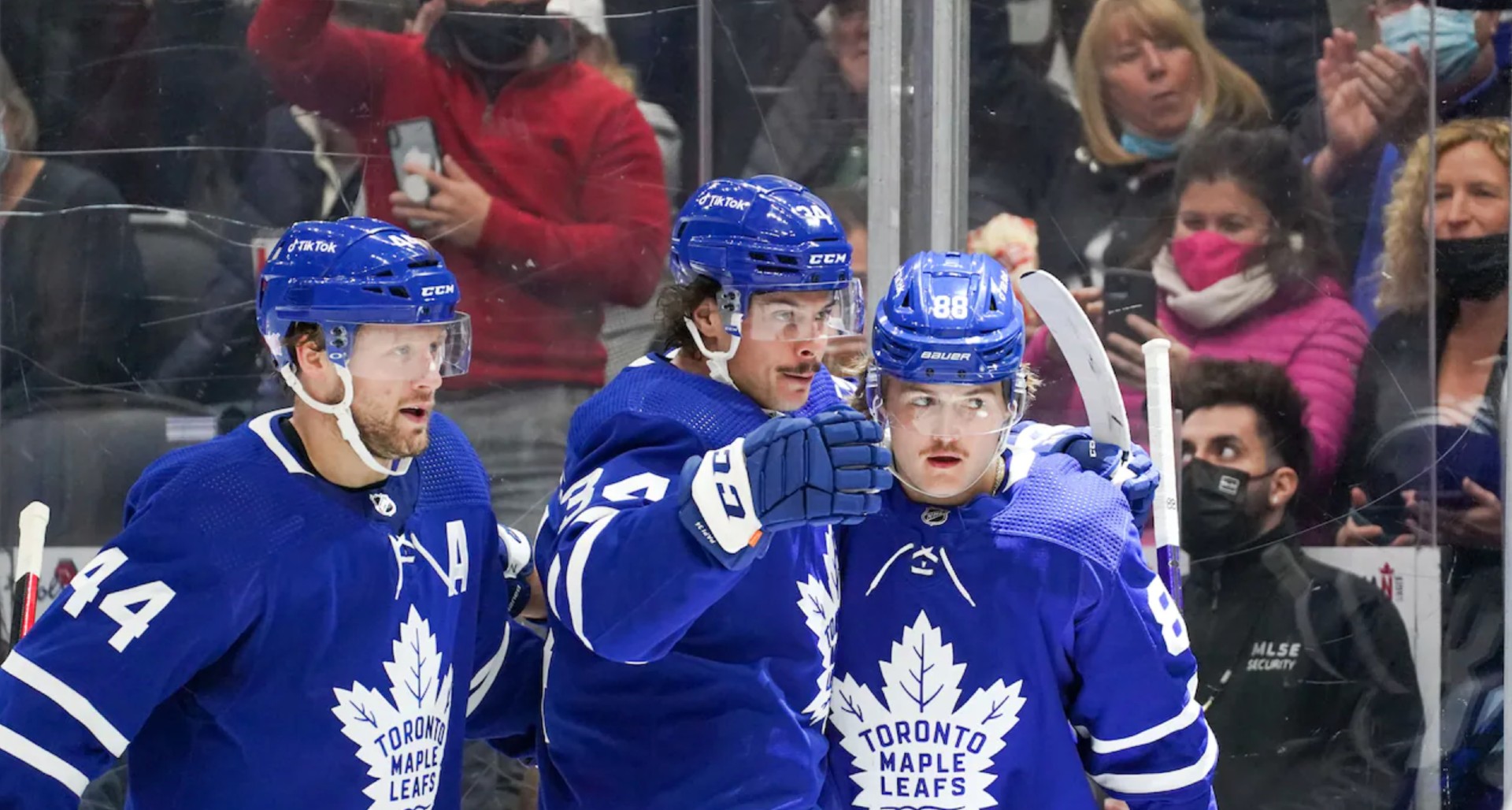The Maple Leafs are putting together a historically-good power play this season that should probably be garnering even more attention than it has received to this point.
Their success rate of 31.5 percent is on track for the second-best power play in recorded history behind only the 1977-78 Montreal Canadiens team that converted at 31.9%.
It is particularly amazing considering nobody on the team is leading the league in power-play goals, assists, or points. Auston Matthews is right up there, to be sure (tied for third in power-play goals, tied for fifth in points). But the strength of the Leafs‘ power play is its versatility and how they move around their chess pieces from shift to shift, power play to power play, and game to game.
The Leafs’ big four – which should really include Morgan Rielly and be called the big five if we’re going to call it anything at all – has been full value on the power play as the Leafs are flirting with history a little over halfway through the season. They have 41 power-play goals so far this season and their expected goals number is roughly 34; maybe it won’t be sustainable at this rate, but this is also why teams pay up for high-end shooting talent.
So, what is the Leafs‘ power play doing so well?
First off, they gain the zone efficiently. A lot of people hate the drop pass power-play breakout because it looks awful when it doesn’t work, but there is a reason why almost every team in the league tries to replicate it – it works!
Below, watch the Leafs slice through the neutral zone and move around to create confusion, and note how it all stems from a drop-pass breakout. When Tavares travels down the wall, he wants to create one of four options:
- He bounces it back off the wall to the defenseman up top
- If that is covered off, he chips it low to Matthews, who is skating in hard through the middle after passing it over to the wall
- Tavares curls and keeps the puck himself
- If all three of those are covered, he rims it all the way around to the far side
I
You simply can’t cover all those options well as a penalty kill. When a PP has five elite offensive players on the ice at once and they execute, the PK loses the numbers game no matter what.
The key to that goal — beyond the entry — is the Leafs’ movement. They confuse teams with how their top threats around. You can’t game plan specific plays from specific spots when they constantly change.
These goals below are a week apart in December. The faceoffs are on the exact same side, but Matthews/William Nylander line up on different sides. Both lead to goals.
I
The beauty of it is that even though Matthews is one of the best power-play weapons in the world, everyone else on the ice is so good that the Leafs can call the PK’s bluff. Among players who have played at least 50 power-play minutes, Matthews is second in goals per 60 and ninth in shots per 60. He’s the focal point and the main producer, but the Leafs will make the PK unit pay elsewhere if it sells out on him or force the puck low instead of their preferred half-wall spot.
This is something the Leafs struggled with in previous seasons: They didn’t move it low enough, and they became static at times as a result. Tavares is 11th among that same cohort (minimum 50 power-play minutes) in shots per 60 and he generally plays in the bumper role, where they will use him for shot passes, deflections, and to simply funnel the puck on net in any way they can. His six power-play goals are tied for second on the team with Nylander – and Nylander scores them in much different ways than Tavares.
On this goal below, Matthews barely factored into the play, but the Rangers are stretched wide to cover his threat, so Marner and Tavares responded by playing pitch and catch down low while moving around to create space.
I
The Leafs will mix in power plays where Marner and Matthews change sides mid-power play. They will almost trade sides after each clear to mix it up and confuse the opposition. At times, Marner will pull down low or to the bumper spot, and Nylander will set up on the half-wall as a more viable shooting option.
These interchanges impact how the opposing penalty kills play the Leafs. Nylander is a shooter, and Marner is a passer; they’re making already shorthanded units contemplate a lot and adjust on the fly. That’s no easy feat.
If all of that isn’t enough, the Leafs also have Jason Spezza wheeling and dealing as the leader on the second unit.
Notes

– You can look at the Leafs’ losses against Calgary and Vancouver as examples of getting goalie’d – and they did run into great goaltending performances – but they’ve also been playing with fire by falling behind early in games lately. Those things tend to equal out over the course of the season. Against Detroit and New Jersey (the first time), they came back and got away with it. Against Calgary and Vancouver, they did not.
– The Leafs have been running some nifty faceoff plays of late. They scored a big goal that way against Carolina to take a lead into the third period, with Morgan Rielly rolling down the wall on a give-and-go with his partner before finding Auston Matthews (who won the faceoff before pulling up high to the top of the circle) for a one-timer goal.
In the next game against Calgary, they started on the left faceoff circle yet again in the offensive zone and won it to Rielly on the left, where he beelined down the wall while Michael Bunting — lined up on the left outside hashmark — ran a pick on the Calgary defenseman Chris Tanev. Rielly then whipped it in front to Mitch Marner, who was driving the net, and they almost got a bounce.
One went in and one didn’t, but they were both variations of set plays involving the top line and Rielly as a playmaker that turned into quality chances.
– It had to feel good for Alex Kerfoot to score early against Seattle following the game in Vancouver where he played a season-low 10:35 and didn’t take a shift in the final 10 minutes game (replaced by Mikheyev).
– Speaking of Ilya Mikheyev, he now has three points in his last nine games, and in five of those games, he put only one shot on net; in one other, he had zero. He’s still shooting over 15 percent and he’s at 10 points in 17 games in total, so I think the offense will cool off further as things continue to even out. At that point, it will be interesting to see how the third line looks when Mikheyev isn’t shooting the lights out — and David Kampf is also riding a career-high shooting percentage at the moment.
– William Nylander got burned trying to regroup for a line change after a long shift for the 1-1 goal against Seattle. He was unlucky that the puck hit the ref, leading to a Seattle Kraken goal. While he was unlucky there, it is a systemic play that the Leafs have been burned on before.
It’s not a criticism directed at Nylander – they are coached to play this way. There is a time and place for regrouping, but when the hockey tightens and teams pre-scout it and sit on it, it can lead to trouble. Eventually, the priority has to be to simply get the puck out in those situations, but that has to be emphasized by the coaching staff.
Quotes

“It hasn’t been to the level that they had established. It starts to snowball a little bit. You start to overthink things a little bit.
My message to that line is to continue to skate, work, and bring the level of intensity every shift. That is going to set you up for success be it with the puck or without the puck — whatever the game is going to call for to do that.
They have been a little bit disconnected in that way. I am not focused necessarily on the production part of it. I don’t know how many breakaways or clear looks Willy has had in the last few games that normally go in for him.
There have been opportunities for goals there, but just looking in terms of controlling play and getting extended shifts on offense, there hasn’t been as many here of late. We would like to get that going.”
– Sheldon Keefe on the play of the Kerfoot – Tavares – Nylander line (before the Seatlte game)
I have mentioned this before — and we’ve seen some signs of it here (with the coaching staff shifting up the lines and making tweaks within games) — but the Leafs coaching staff appears to have the same concerns as many of us do. The second line hasn’t been great and certainly isn’t dominating in the way one would expect given the talent on the line. As currently constructed, I am not sure the forward group can be shaken up simply by line shuffling in order to improve it.
“Auston Matthews is arguably the purest shooter or goal scorer in the league. He is a power guy. And Marner is the whole package. He doesn’t get enough credit … the way he manages pucks and makes plays. That’s a big challenge, those two guys.”
– Darryl Sutter on Auston Matthews and Mitch Marner
When you see it every night, you don’t always appreciate the elite play on display, but opposing coaches sure notice. For it to come from Darryl Sutter — and for him to praise Mitch Marner’s overall game rather than just his offense — is really something. Coming from him, it means a lot — more than most coaches.
“When you’re one of the top teams, we find we’re getting the best out of teams that are in the bottom of the standings because it’s a benchmark game for them. My wife laughs at me because every time I leave saying, ‘It’s a big game tonight. We gotta win this one.’ She just snickers. It’s the same ol’ song and dance. But it’s true. That’s how you feel. Like, we played Detroit the other night, and Detroit is a team quite a bit below us. But they gave us a great effort. They’re fast; they’re hard to play against. There’s no free nights anymore.”
– Jason Spezza on the difficulty of a full 82-game season now compared to a decade ago
I am not sure I fully buy it, and it should be noted that everything has been pushed back a month this season due to the Olympics/non-Olympics scheduling plus COVID. They’ve only played 46 games so far! That said, it is undeniable that for a top team like the Leafs, they generally get their opponents’ best each game.
The hockey on the whole has at least a few levels still to reach down the stretch of the schedule (which is a commentary on the league — not the Leafs — to be clear).
Tweets of the Week

Fewest games to reach 400 career points with Maple Leafs
Auston Matthews 372
Syl Apps 387
Mitch Marner 392— Sportsnet Stats (@SNstats) February 15, 2022
As has been said here repeatedly – these are worth sharing every time something of note happens. In terms of talent, this is a golden era in Leafs history.
Last 73 days:
Canadiens GM: fired
Canucks Head Coach and GM: fired
Jets Head Coach: stepped down
Canadiens Head Coach: fired
Oilers Head Coach: fired— Sid Seixeiro (@Sid_Seixeiro) February 10, 2022
Life as an NHL franchise in a Canadian market really is a different kind of beast in terms of the level of coverage, scrutiny, and pressure. That’s not to say there aren’t American markets that are difficult to play in, by the way.
It was 23 years ago today that the @MapleLeafs last played at the storied Maple Leaf Gardens. 🍁 pic.twitter.com/ceZRAogpRF
— NHL (@NHL) February 13, 2022
Pretty cool and definitely worth sharing.
Five Things I Think I’d Do

1. In the seemingly never-ending question of, “will Jake Muzzin and Justin Holl ever actually sustain better play,” I think the one real bullet left in the chamber is swapping the forward lines they are playing with rather than shuffling the defense pairings.
In other words, play Muzzin – Holl with the Auston Matthews line more than the John Tavares line. These are basically five-man units at this point, and the second line and second pairing haven’t been great. Perhaps the Morgan Rielly – TJ Brodie pairing — which has been quite good — can help the Tavares line improve, and perhaps the Matthews line — which has been one of the best in the league — can help the Muzzin – Holl pairing stabilize.
At a minimum, maybe the coaching staff can get them a few more easy shifts per game with the hope of repairing their confidence. The pairing has played 62 minutes with the Tavares line and has managed a shot share under 45 percent and an expected goals hovering around 43 percent in those minutes. In under 30 minutes with the Matthews line, they have a shot share over 61 percent and an expected goal share over 65 percent.
For what it’s worth, the Rielly – Brodie pairing has played over 90 minutes with the Matthews line and has recorded a 56.25 percent shot share and 58.21 expected goal share in that time.
2. If Jason Spezza and Pierre Engvall are on the fourth line together, I think Engvall should be the centerman. He’s a better skater, and in general, he is often the fresher option rather than asking the 38-year-old Spezza to handle center duties night after night.
Spezza can take the faceoffs in favourable spots and then shift over, but he shouldn’t have to cover the whole ice at center at this point in his career. To be honest, I don’t think he’s particularly capable of doing so, either. Just over half of Spezza’s points on the season (nine of 17) have come on the power play. I think that has been deceiving at times when evaluating his game overall.
3. On that note, I think the Leafs have to find ways to rest Jason Spezza. He has played 42 of 46 games so far this season — that’s way too many. They’ve basically made the playoffs already; there’s no need for this. His play and impact have fallen off as the season has gone on so far. He has nothing to prove, and they don’t need him slogging through the grind of the season (which to me falls firmly between games 40-60).
The same goes for Wayne Simmonds, who looks arguably worse and whose wife just had a baby. Let him rest up. I get that there are cap implications, but I’d almost rather run Travis Dermott at times in spot duty in order to let these two rest.
4. I think I’d be trying out a few other center options while we’re at it, whether that’s more reps for Alex Kerfoot or William Nylander. I have mentioned this before, but if the Leafs are going to look at spreading out three lines again, they can’t have David Kampf as one of those centers. I love what he brings, but he’s a defensive specialist. He’s having a career year offensively right now and he’s not even pacing for 30 points while shooting roughly four points above his career-high shooting percentage.
You can’t pair Nylander alongside him for a game and a half and conclusively decide that spreading the talent out over three lines doesn’t work – they never gave it a chance. Most casual observers could have told us that this was never going to gain traction.
Ideally, Kampf is the fourth-line center considering what he brings (/doesn’t bring) offensively, but he’s so solid defensively, Auston Matthews is such a stud all around, and their power play is so elite that it makes up for it over the course of an 82-game season. If the power play has a bad series and/or Matthews is sawed off by the other team’s top line, I’m not so sure it will hold up as well.
I’d build in contingency plans now as opposed to the annual spring tradition of cobbling things together for the first time.
5. If I was the coaching staff, I think I wouldn’t approach the goaltending tandem as though Jack Campbell is the undisputed starter who needs the rope to run with it. I get that he made the All-Star Game this season and has been great since he came to Toronto, but he doesn’t have the track record to simply hand over the keys. I’d be trying a platoon to keep them both sharp and ready, and whoever emerges, so be it.















![John Gruden after the Leafs prospects’ 4-1 win over Montreal: “[Vyacheslav Peksa] looked really comfortable in the net… We wouldn’t have won without him” John Gruden, head coach of the Toronto Marlies](https://mapleleafshotstove.com/wp-content/uploads/2025/09/gruden-post-game-sep-14-218x150.jpg)


















